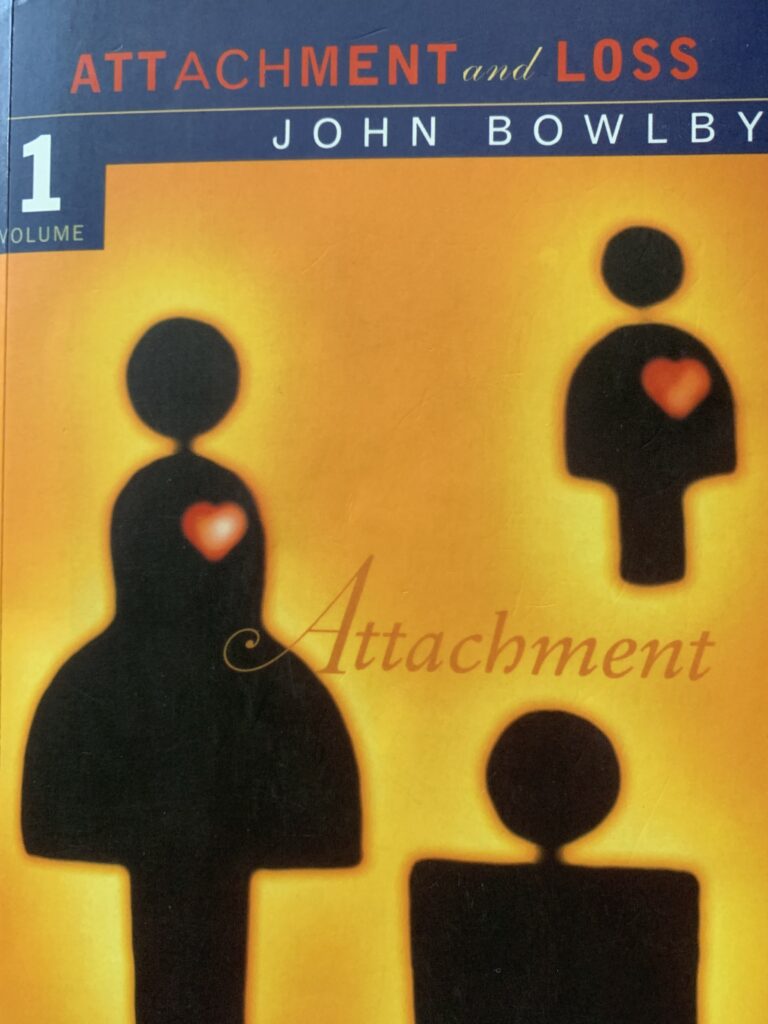
INTRO
This first volume of three in John Bowlby’s series on Attachment and Loss, is considered seminal to Attachment theory. Bowlby was a British psychiatrist and psychoanalyst and he was not satisfied with his profession’s views of child development. His theory building was already two decades in the making, when he published this first volume in 1969. Dr. Bowlby begins, by framing his essential criticism of Sigmund Freud’s psychoanalysis. Simply that Freud “rarely drew for his basic data on direct observation of children” (p.3). So Attachment theory provided a counter discussion to psychoanalysis, which at that time, was the only social science attempting to make sense of personality development and mental health.
IMPORTANT ASPECTS
John Bowlby’s point of view of relies on direct observation of child behavior to signal emotional coping. Plus his view reveals how Attachment anchors the developing personality and early separation introduces trauma. In fact, the emotional stability provided by Attachment is a kind of homeostasis, like described in biology, necessary for survival in all species of mammals.
Bowlby re-introduces an idea long since trashed by psychoanalysis, that behavior can be instinctive. Because he recognized that Attachment spontaneously emerges when mammals become mothers, and today we realize Attachment instincts come alive in anyone becoming a parent. But back in the 50s and 60s, Bowlby highlighted the patterns of nurturing among mothers because these were easy to observe in all mammal species.
I think Bowlby does a masterful job of explaining instinctive behavior because it’s complicated by real life circumstances. “Instinctive behavior is not inherited: what is inherited is a potential to develop certain sorts of systems termed here behavioral systems…” (p.45). To me, this means we are each born with the potential for Attachment with our caretakers. Yet without sufficient caregiving, Attachment behaviors become distorted and additionally cannot do the intended work of Emotional Development.
From my own experience, I know distorted behavior can be over-controlling or inhibiting, resulting in less emotional expression, less exploration, and less spontaneous play. Or, distorted behavior can be under-controlling and impulsive, resulting in distractibility, too much emotion, reckless exploration, and an insatiable desire to play without restrictions. Plus, children living with abuse will instinctively become aggressive and threatening, even as toddlers.
I think Bowlby also does a masterful job of explaining healthy Attachment behavior, which had never before been tackled in a comprehensive way. Unfortunately, Freud’s world was missing this important chunk, “Everything in the sphere of this first attachment to the mother seemed to me so difficult to grasp in analysis…” (Freud, 1931).
MAPPING DEVELOPMENT
Maybe most important to me, is how Bowlby maps the development enabled by healthy Attachment. Simply by observing children, Bowlby discovered phases of behavior patterns, with infant Attachment being a sensitive period. He mapped how responsibility shifts in toddlerhood, for maintaining physical proximity with the parent. How play will emerge, if there is a balance of familiar, like Mom sitting close by, and unfamiliar to engage curiosity. How Separation Anxiety and fear of strangers are distinct yet related. How rocking an infant at the normal adult pace of walking and singing or sounds within the normal range of human conversation, are both emotionally calming.
John Bowlby even includes a couple of chapters to review misconceptions and old controversies. I know this is important, since many parenting and teaching practices of today, still hold unexamined assumptions embedded before Attachment theory could clarify and explain. So we get to rethink concepts like; bonding, ego-centrism, attention-seeking, transition items, anxiety, and security in relationships. I appreciate this forward thinking on the part of John Bowlby.
SUMMARY
Attachment and Loss Volume 1 is important foundational reading to understand Attachment theory. I believe this book is readable for anyone interested in child and teen mental health. Although there tends to be jargon, the concepts are carefully explained.
You’ll gain insight to better understand infant distress, toddler fears, child misbehavior, and even teen distress. Probably, you’ll make the shift from behavior analysis and mental disorder labels created by the medical model of psychiatry, to adopting a developmental view of children’s mental health. For me this book is a 10 out of 10.
I highly recommend the other two volumes by John Bowlby;
- Volume 2 Separation: Anger and Anxiety
- Volume 3 Loss: Sadness and Depression
Do you prefer a book which is lighter, modern, and totally engaging?
- Johann Hari (2018) “Lost Connections: Uncovering the real causes of depression – and the unexpected solutions”
Book Review by Devon Wolfe
WolfeWisdom.ca
devon.wolfe@wolfewisdom.ca
BEd Special Education
MSc School Psychology
Cert. Addictions Studies
“Our presence is powerful in the life of a child.”
